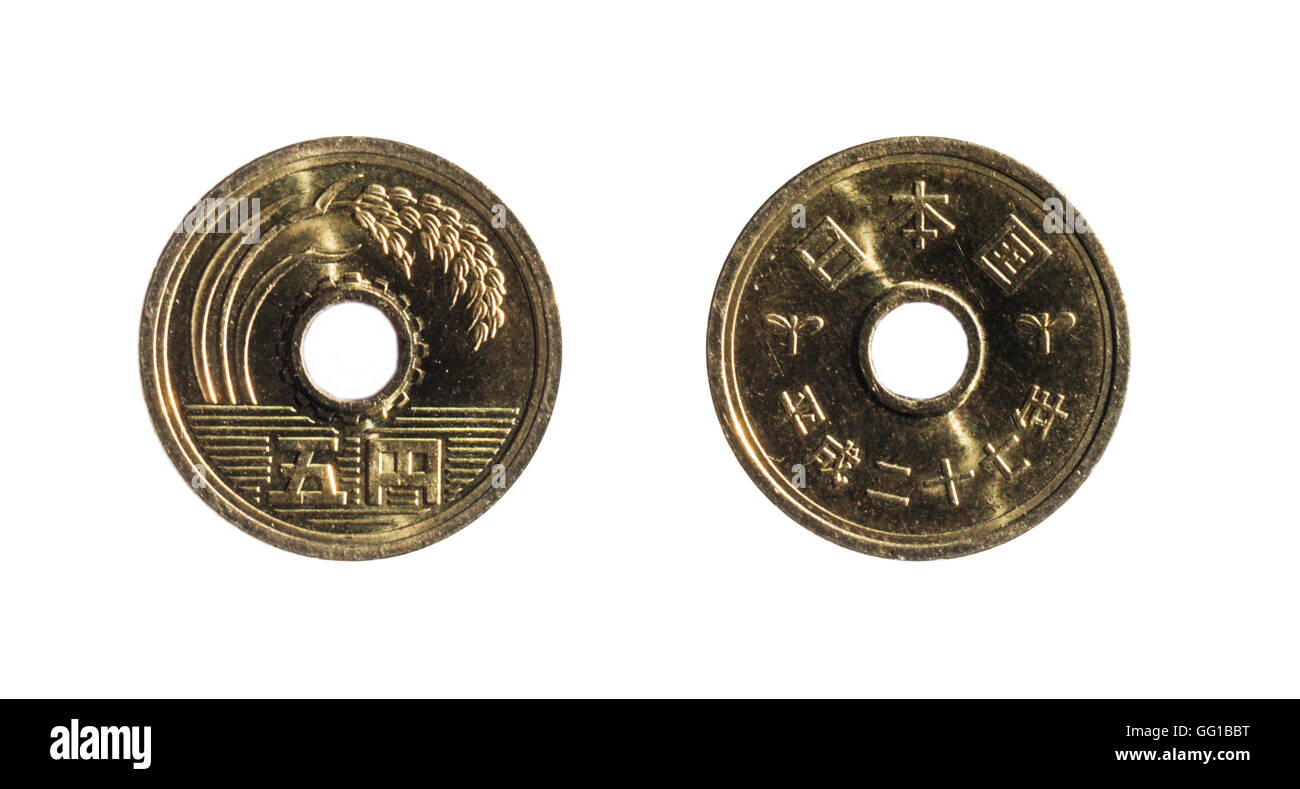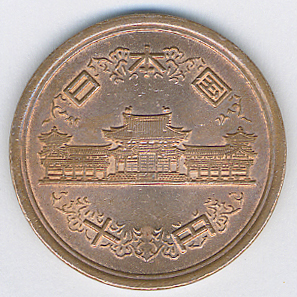- Get the best deals on 5 Yen Coin when you shop the largest online selection at eBay.com. Free shipping on many items Browse your favorite brands affordable prices.
- Japanese coin 5 yen Japanese Yen (円)=100 sen Emperor Hirohito Shōwa period - 昭和 (1926-1989) 5 yen 1948-1949 5 yen 1949 (1948, 1949) brass Diameter 22.0 mm. Edge smooth circulation coinage 5 / National Diet Building / YEN GREAT JAPAN (NIPPON GINKO) / pigeon / SHŌWA 24 YEAR KM#71 Coin value - $1. 5 yen 1949-1958 5 yen 1950.
Detailed information about the coin 5 Yen, Heisei, Japan, with pictures and collection and swap management: mintage, descriptions, metal, weight, size, value and other numismatic data.
Early Japanese coins like this one are enjoying strong collector interest. This pattern, with the encircled dragon on the front and two-sided wreath and blossom on the back appears on the silver coins of denomination 5, 10, 20, and 50 Sen and 1 Yen. There are 100 sen in one yen. Copper and gold coins also carry the same pattern. This page addresses only silver coins. View our page on copper issues here.
The dates of these cois are from the Meiji Dynasty, which started in 1867. To find the date of your coin, use the listing of Japanese characters below and a web site such as AllCalendars.net. The coin in our picture comes from Meiji 30, or 1867 + 30 = 1897.
Catalog values for these coins are quite high, especially for coins in good condition. The coin in our picture is in average circulated condition. Gague your coin from this one, and apply the concepts on our Important Terminology page to convert catalog values to actual values. Remember, also, that these coins, especially the large ones, are often counterfeited, so be sure you trust the person involved in any transaction. If you think your coin may be valuable, find a knowledgable coin dealer or coin collector and get an opinion. CoinQuest and web sites like it are no match for an actual, first-person inspection of a coin. First-person inspection always gives better estimates of value than any price guide.
5 SEN
worn: $10 US dollars approximate catalog value
average circulated: $25
well preserved: $40
fully uncirculated: $75
coins dated 1876 are usually worth half these values
coins dated 1874 are worth about 5 times these values
coins dated 1880 are very rare and are worth $2000 or more
10 SEN
worn: $5 US dollars approximate catalog value
average circulated: $10
well preserved: $30
fully uncirculated: $65
coins dated 1873, 1895, 1896, and 1897 are usualy worth half these values
coins dated 1891 and 1892 are worth about 3 times these values
coins dated 1880 are very rare and are worth $5000 or more
20 SEN
worn: $5 US dollars approximate catalog value
average circulated: $12
well preserved: $20

 fully uncirculated: $50
fully uncirculated: $50coins dated 1873, 1874, 1875, 1891 and 1900 are worth about twice these values
coins dated 1888 are worth about 5 times these values
coins dated 1880 are very rare and are worth $1000 or more
50 SEN
worn: $15 US dollars approximate catalog value
average circulated: $30
well preserved: $80
fully uncirculated: $200
coins dated 1885 are worth about 5 times these values
coins dated 1874, 1875, 1876, and 1877 are worth at least $1000 even in worn condition
coins dated 1880 are very rare and are worth $2000 or more
1 YEN
worn: $75 US dollars approximate catalog value
average circulated: $120

5 Yen Coin
well preserved: $225fully uncirculated: $850
 coins dated 1874, 1878, 1879 are worth at least $300 in worn condition, much more if in better condition
coins dated 1874, 1878, 1879 are worth at least $300 in worn condition, much more if in better conditioncoins dated 1875 are very rare and are worth $4000 or more
The image above compares a valuable 1875 yen from world-reowned coin dealer Heritage Auctions to a crude copy. The details of the pattern vary greatly, but the most important give-away is the terrible surfaces of the fake and its mushy appearance. Counterfeits of valuable Chinese coins abound. Let the buyer beware.
Created (yyyymm): 201108, Last review: 201508
Appearance: Normal round coin Metallic gray Letters: Latin Chinese style
Years: sort: 1873, filter: 1873 to 1900
Image: japan_10_sen_1897.jpg
Original inquiry: slight damage but otherwise well preserved. all letters are japanese and i do not understand japanese. only latin letters on coin say '10 sen'. slight wear on lettering. one side appears to have a dragon, though i can't tell. other side has a wreath much like the reverse if an indian head cent, and has a single cherry blossom above two japanese letters. dragon circle chrysanthemum dragon chrysanthemum wreath
5 Yen Coin Meaning
When I was a kid, my father showed me all the books and souvenirs about and from Japan, among it a few coins. So the 5 Yen Coin has a significant meaning for me personally, because it was the very first japanese coin I ever saw or held.
But the 5 Yen coin actually holds a special place among the different coins of the japanese currency. Though it is not the only coin with a hole in it (the 50 Yen coin does have one as well), it’s the only one without arabic numerals.
The japanese word for 5 is “go” and the word Yen is pronounced “en”, which makes the pronunciation for 5 Yen “go-en”, a homophone to goen (御縁). 縁 – en means connection or relationship (sometime seven translated with “fate”), while 御 – go is the respectful prefix. Where would you want more to build a relationship, then when you are offering an Osaisen (お賽銭) – money you throw in the offering box before praying at a shrine.
I remember my new year’s eve at the Meiji Shrine in Tokyo, where they had a huge area for all the people to throw their money, since it would have taken too long for everyone to go to the offering boxes individually. The ground was covered with 5 Yen and 50 Yen coins.
Though I’m always interested in learning the meaning behind traditions, I also very much liked the explanation, a very friendly old lady told me, when she guided me through Nara on my first visit to Japan: “Always throw 5 Yen or 50 Yen coins. They have a hole in the middle and will catch the luck for you in it.”
Have you seen people throw five Yen coins or do so yourself?